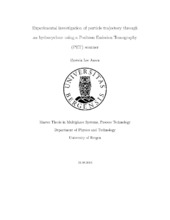| dc.description.abstract | Hydrocyclones are much used in process technology and in many different industrial applications. In the oil and gas industry the hydrocyclones, both gas-solid and liquidsolid cyclones are widely used. Getting the sand out of the oil and gas production flow is critical for the production- and separation- equipment. Also for environmental and health concerns, efficient hydrocyclones are needed. Today the knowledge about the flow pattern inside the hydrocyclones is very limited. Many models are derived, both theoretical and experimental, the accuracy of which is less than satisfactory because of limited knowledge of the flowpatterns of liquid and particles. The motivation in this present investigation has been to gain a better understanding of the trajectory of a particle. A better understanding of the particle trajectory, will represent a significant step in the direction of designing more efficient hydrocyclones. The equipment used in this investigation is a Positron Emission Tomography (PET) scanner. The basis of the PET scanner is detection of radioactivity. A particle is put in a radioactive liquid and absorbs radioactivity for some time. PET scanner measures the actual position of the particle with an accuracy of less than 1 mm each millisecond. The outcome of the experimental investigation is images of particle trajectories that never has been revealed before. Accuracy of the measured result are without comparison much better then the state of knowledge today. The results of the experiments show that when the particle moves downward the outer hydrocyclone wall, the particle turn and follows the inner upward flow, this repeats itself several times. Additional analysis has been carried out to attempt to find out the reason for this very interesting trajectory. The reasons considered for this reversal of axial flow direction are disturbances in the tangential velocity or the particle actually impacting on the wall. Additionally the particle residence time has been investigated. Because of lack of sufficient amount of experimental results at this time, no definite conclusions can be drawn on these issues. In one experiment it might look like the particle hits the wall, but at this time in the investigation it seems more like the trajectory is random rather than specific. Either way this research is a breakthrough in hydrocyclone development, and will give much information to designing better cyclones in the future. In addition to this the present investigation shows that PET generally is a great working tool also for high velocity particles. This will probably be much more appreciated and used in the future. | en_US |
